
Welcome to my classroom. I will take you through the lesson planning for one of my preschool groups. They have just started to learn English, they are four and they come to us only once a week.
This was our lesson number 5 and I taught it last week, just one of the lessons, without any fireworks or magic, just what we do. The only thing that was different was me taking notes and photos every step of the way. The planning took about twenty minutes (plus photocopying and preparing the classroom).
This IS how I plan and it was only a few months ago, while talking to a friend and a colleague (insert virtual hugs to Vita), I realised that if I had to pick up a metaphor for my approach to lesson planning, I would go for a cake: I figure out what I want (the visualisation of the amazing piece of baked goods, just a second before you cut it up to serve) and then I come up with all the ingredients to buy, all the equipment to prepare and all the steps to take to get there. Just like while making a cake.
Welcome to my lesson, step by step. Get ready for a lot of I’s!
Step 1: Getting started
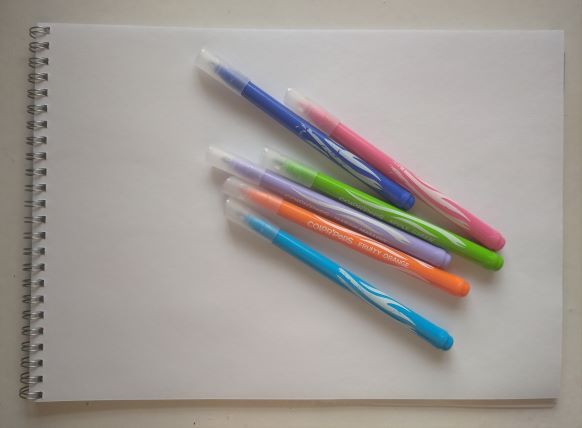
An A4 piece of paper is where I always start. A single piece of paper and a few colourful markers. I use the same approach to planning for all my lessons, regardless of how old the students are or what their level, but for pre-schoolers it is especially important.
Leafing through the pages is not necessary and, let’s be honest, not recommended or even impossible when simultaneously you are managing a group of four- or five-year-olds. The lesson plan is always on the wall. It is relatively simple and thanks to the big font, the structure and the colour-coding, I can read it, even from the other end of the classroom. Sometimes, I take it around with me and pin it in the other corner of the room, all that depending on the activity. If for example we are doing something completely new, for the students or for me, my notes for this particular activity are a lot more detailed.
Step 2: The framework
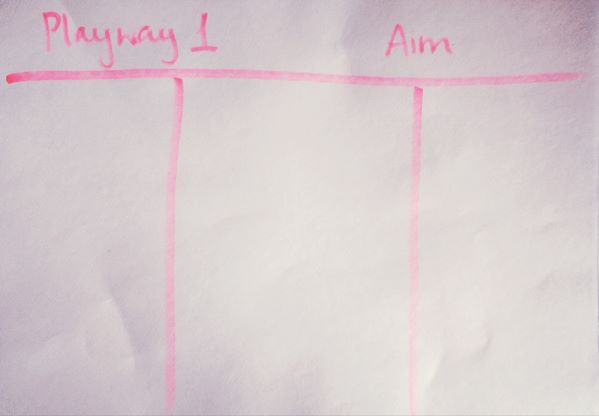
This is the typical framework that I use for all my pre-primary groups and individual students. The lesson is divided into the three main slots, regardless of how long the lesson is. As a result, the length of each third varies and it can last 20 minutes in one real hour class, 15 minutes in one academic hour class or even 10 or 5 minutes in the shorter online classes that lasted 30 or 15 minutes respectively. As with any lesson planning, assigning time slots should be only approximate because a) anything can happen b) we adapt our and the coursebook authors’ ideas to what actually happens in a particular lesson. To be honest, if I were to give up one lesson plan / lesson ingredient / craftsmanship element, timing would be the first one to go.
I start from the scratch in every lesson although I have been playing with the idea of improving the approach – printing the template, half-filled in with all these elements that are constant, then laminating it and using whiteboard markers to plan to minimise the time expenditure and the workload but I have never got round to it. Not yet, anyway.
Step 3: The aim
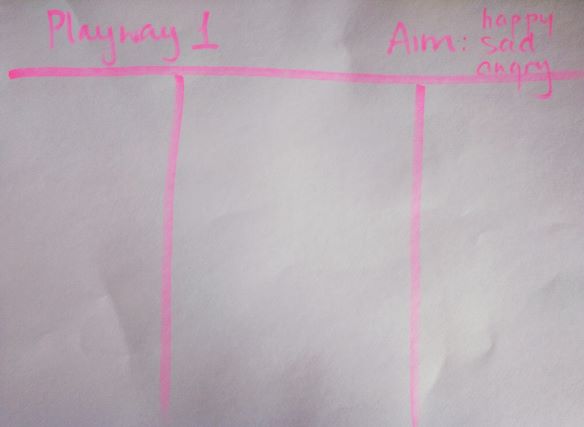
I start with the lesson aim. I mean, we all do, in a more or less conscious way. Only about a year ago, though, I started to force myself to verbally formulate the aim of each lesson and to write it down. The results of that little, non-time-consuming teaching habit have been nothing short of amazing.
I know most of the coursebooks that I am / we are teaching with very well, I have gone through most of them once at least and I have my favourite activities and solutions and so on and, of course, at the bottom of my brain, I know why I do this or that. But, having to actually think about a particular group and a particular lesson, on a particular day and having to say it out loud has made a bit difference and has made me more aware of what I do and why.
But there is more to it, too. There have been a few occasions over this year when I really wanted to include something to supplement the coursebook, a game, a song you find or an idea you wake up, include it at all cost, just because the idea seemed very appealing. On those few occasions, the lesson aim got skipped or left for the very end of the lesson planning, as if by accident.
Only it was not by accident. Because when I got to the point when I was ‘just’ supposed to summarise it in the lesson plan, I simply could not. It did not come together because the lesson, at this point, was just a collection of activities, without any real focus or an obvious outcome. All these lesson plans were redone and the activities reconsidered.
For that reason, now I always put the lesson aim at the top of the page, as my frame, my spotlight, my runway. A clear lesson aim also helps to reflect on what happened in class afterwards.
In this particular lesson, I wanted my students to start talking about emotions. They had already been exposed to the three key words (happy, sad, angry) and their symbolic representations but without actually producing much. In this particular lesson, I wanted to try to take it a bit further, to the production stage, ideally in the form of a full sentence ‘I’m happy / I’m sad / I’m angry’.
To be honest, ideally, this is what should have been written on the page ‘I’m happy/ I’m sad / I’m angry’ but it got compressed to only three words, mainly because I have taught the lesson a few times already and it would be a full sentence by default. Just to prove that the lesson plan was for the lesson itself and not for ‘publication’.
Stage 4: I will always love you
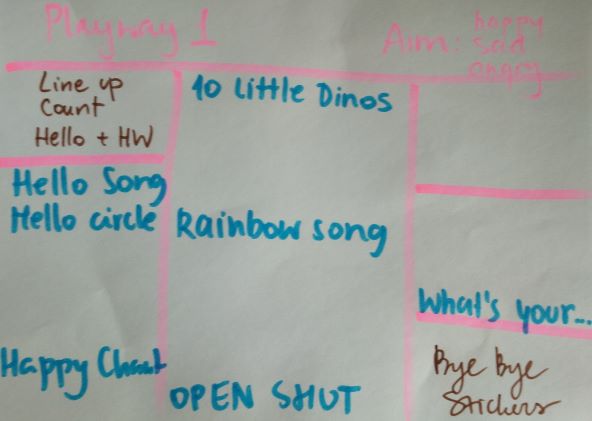
This is the easy thing. The first and the last block, in brown, are the admin bits, with the students entering and leaving the classroom.
We line up in front of the classroom, count how many people are present, we say hello officially and we check the homework (more on that kind of a hello routine soon to come!) and we sing our goodbye song and choose stickers, get homework and choose the stickers before everyone goes home. These never change, although sometimes I only send the homework through the WhatsApp group or explain it directly to the parents. This was a standard lesson, though.
The other element that always appears at that point are all the songs and chants to be sung in class. These depend on the topic of the lesson and later on, the students can sometimes decide which one we are going to sing. This group here is at the very beginning of their English adventure so for the sake of establishing the routine and because we only know a few songs, we sing all of them in every lesson.
Songs work here as some kind of punctuation marks and during the lesson, we basically sail from one song to the other. It helps to ensure the balance between settlers and stirrers or songs offer at least a tiny little bit of a change of a pace and an opportunity to move but they also help to ensure that there are periods of the lesson when we all do something together so it helps to keep the balance of different interaction patterns (whole class vs individual work, pair work or taking turns).
Step 5: The centrepiece
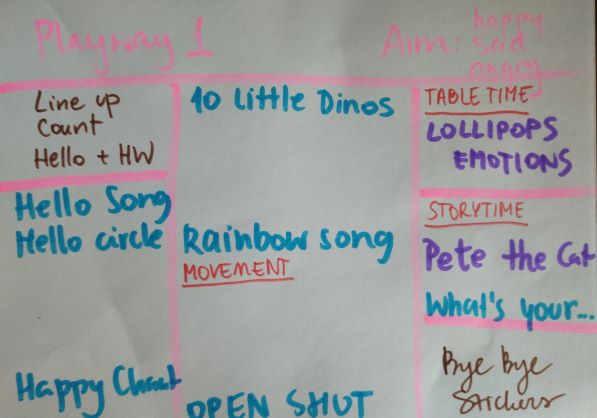
At this point, I am adding the main activity, our focused task during which we are set to make the lollipop puppets with our three emotions (plus colours and some functional language). I have done this activity in that format a few times and for that reason there are no detailed instructions, the staging is already in the blood.
Another thing that appears at the time is the storybook. At this point in the course, we use storybooks only as supplementary material to revise and to reinforce the target language from the lesson and this is how Pete the Cat helped us. We revised the colours and emotions only using a different resource.
Step 6: The familiar
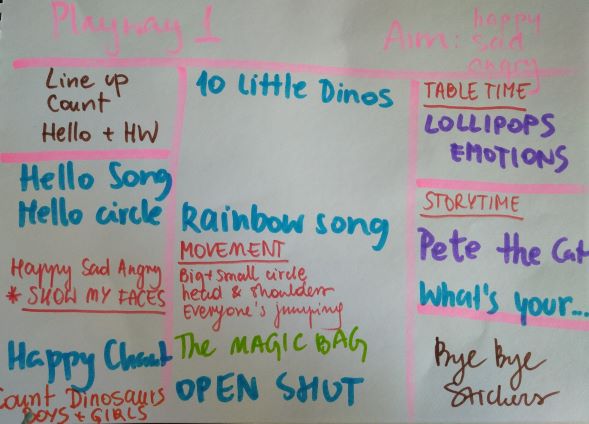
The next step is adding the other elements of our routine. These are not as constant as the hello or goodbye routine but not as changeable as the focused task or the target language practice.
Since it is the beginning of the course, there is not much to pick out from or to revise and since we are still working on building our routines and I try not to add too many new elements, not to overwhelm the kids.
Our revision activity has been the same for all this time: we count up to ten on fingers, we count the people present, boys and girls and teachers and we count other things, in this lesson dinosaurs, in this lesson in a book and our plastic toys.
Our music and movement has been pretty much the same from the beginning of the course and it is only now that the kids are properly enjoying the activities. This applies to the songs and the magic bag game, in which we use plastic fruit. They don’t know the fruit names so at this point we only focus on their colours (‘It’s green’).
As for our How are you today part, the plan was to do it in the traditional way but with the introduction of the finished product. I thought that this might help the kids become aware of what this toy is and how to use it (pick one and place it in front of our face, while saying ‘I’m happy’). By the time we’d get to making our own lollipops, they would already be familiar with them. It would also help with giving the instructions.
Step 7: The key elements
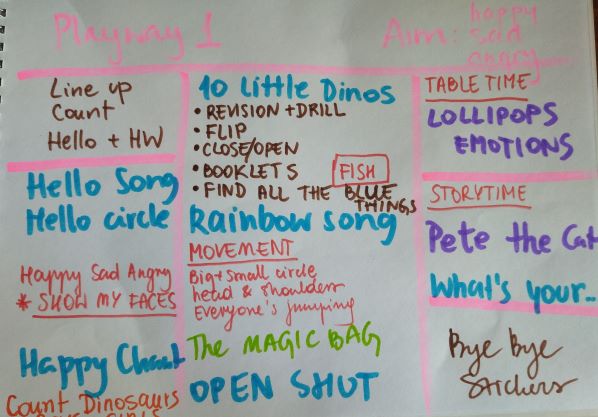
The things to add now, will be the details of working with the target language and with the revised language, in order to ensure that they best contribute to the completion of the focused task.
What I did plan, however, was the colours practice with a variety of activities: not quite in the order in which we did them. The main and the new one here was ‘open/close’ also known as ‘what’s missing’, a memory game and the most challenging activity here (as it involves cognitive skills and language production, focus). Everything else was either a preparation for that or a supplementary game, which can but may not be used, in the end. I like to make a list like that to prepare myself for their different moods, participation and involvement levels, etc. Having a list of potential games which we can play, without any major changes to the materials set or the seating arrangement I found it to be quite useful.
The fish game here acted as my potential plan Z, only if we have time. In the end, I used it later in the lesson, instead of the magic bag activity since they were both quite similar (students taking turn to perform an individual task with a motor skills development focus and colour revision.
In this lesson, the connection between the focused task and the target language practice is not as strong but that is because it is only the lesson 5 in level 1. Thinking about it now, after the lesson, I think that, ideally, I should have included some additional activity to combine numbers and colours, for example in the form of colourful happy, sad and angry faces, that we could categorise by emotion, count etc. So see, there is always a way to improve things)))
Ready!
The lesson plan is ready. Perhaps now, looking at it, in its full, finished glory, it is easier to see why I do not include any timings. The framework itself outlines the time slots for each stage of the lesson, alongside their aims, although they are not articulated clearly and they are the following:
Column A: the introduction to the lesson, hello and revision, the aim: settling in, duration: about 20 minutes.
Column B: working on the target language, the aim: presentation, practice and production, in varying ratios, depending on whether it is the beginning of the ‘unit’ or the end of it, duration: about 20 minutes.
Column C: production, the aim: production, with the hope of more freer practice and spontaneous production, although, of course not during the first few lessons of the level 1 course.
Looking back
The lesson went well and, apart from the few things mentioned already, I did not really have to change anything else. Not that it would be a very bad thing to do. Regardless of what has been planned, the thing that matters most is a group of the little people who are sitting in the classroom, how many of them there are, how advanced they are, how they are feeling on the day. Flexibility, first and foremost. And then – the reflection bit. Because we can always make things better.
If you are new to teaching pre-schoolers, have a look at my post about the first VYL lesson survival kit.
Happy teaching!